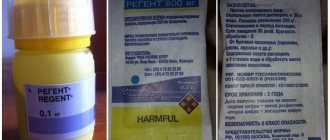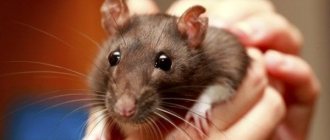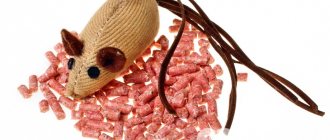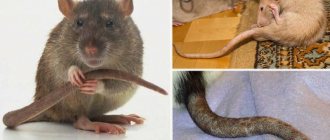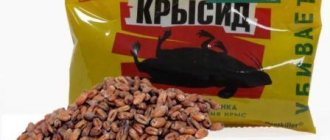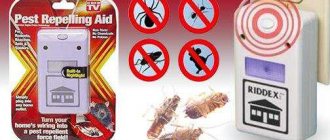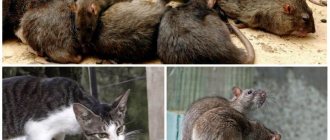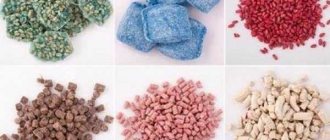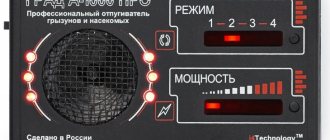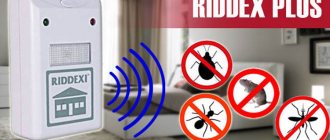Rodents have always lived among people. Residents of the private sector regularly suffer from their invasion - they manage houses and household outbuildings. Rat killers help control pests. Rat poison, if used correctly, will help kill rodents forever.
- What is it? Release forms
- Natural remedy
- Symptoms of poisoning
- Rat Death #1
What is it?
To kill rats, rodenticide is used - this is the official name of the poison for pests. This remedy is one of the most radical. It contains a complex of chemicals that is lethal to rodents.
Release forms
Manufacturers offer several variations of rat poison:
- Briquettes are individually packaged bars that visually and taste like meat and have a plasticine consistency. The poison is green because scientists have noted a good reaction of rats to bright shades. The most famous examples of briquettes are the poisons Ratobor and Krysin.
- Tablets are a popular form of rat poison, a type of briquettes, leading the rodent poison market. Contains a small amount of toxic substance.
- Granules - found in blue, green and pink colors. They look like dry pet food. Convenient to use, their small size allows you to place the granules in hard-to-reach places. One of the most popular products in granules is Typhoon from the manufacturer Rubicon-Agro.
- The grains are similar to granules and attract rats by their appearance. They act gradually.
- Poison in liquid form - like other living creatures, rodents need to drink liquids. The poison is poured into bowls and water in the house and nearby is removed from the access area. The rats drink the poison, then die.
- Powders - used in combination with other products. More often, a mixture is made from them, adding flour or sugar, sprinkled on the pests’ favorite food.
- Gels are poison with the addition of aromas and flavorings to attract the attention of rats. Retains its properties for a long time and is not affected by sunlight and temperature changes. Pests eagerly eat such poison.
Interesting! In terms of ease of use, poison in powder and granules is the leader.
Mice can become poisoned not only after eating bait, but also in the process of trying to clean the body of poison if they get dirty in it.
Natural remedy
If you don’t want to use store-bought products because of their toxicity, you can use folk recipes and prepare homemade poison that will help get rid of rats. This method is used if there are small children or pets in the house - they may accidentally eat the poison.
To prepare poison at home you need to take:
- grains, cookies;
- 0.2 kg of cement;
- 0.5 kg granulated sugar;
- 0.3 kg flour.
The components are mixed and the resulting mixture is placed in the habitats of rodents.
Methods of influencing the pest
According to the nature of their effects, poisons are as follows:
- Chronic - used in small quantities, harmless to pets. After a rodent eats poison, death occurs only after 10-14 days, depending on the concentration of the active substance in the composition. Despite the delayed effect, they are considered effective: rats do not perceive the connection between the use of poison and death, and continue to eat the bait. This group includes anticoagulants.
- Acute action - they work instantly after entering the animal’s body. Prohibited for sale in regular stores, used by pest control specialists. Rodents quickly realize that their relatives are dying due to eating bait, so they try to avoid the poison. Such poisons include agents with a mummifying effect. Their advantages are the absence of the unpleasant smell of decomposition after the death of rats. The body simply dries out over a certain period of time.
Note! These substances are dangerous for pets.
Those who are interested in the question of how quickly rat poison acts should carefully study its variations. Different drugs have their own composition and characteristics of action.
Symptoms of poisoning
As a rule, the first symptoms of poisoning appear within half an hour after the poison enters the stomach. When working with anticoagulants – after 3 days.
As a result of poisoning, the following appear:
- Nausea.
- Vomit.
- Abdominal pain.
- Diarrhea.
- Headache.
- Loss of consciousness.
- Pallor of the skin.
- Changing lip color.
- Manifestation of general weakness.
- Blood pressure problems.
- The appearance of nosebleeds with the presence of blood in the urine, stool and gums.
- Tachycardia.
Naturally, this is not a complete list of the body’s negative reaction to poisoning. The most vulnerable in this regard are children, the elderly, and people with weakened immune systems.
Actions in case of poisoning:
- If the first signs of poisoning appear, it is better to immediately call an ambulance. At the same time, we should not forget about emergency actions.
- First of all, you should rinse your stomach. To do this, you need to drink up to 1 liter of warm water and induce vomiting by placing 2 fingers in your mouth. This procedure should be repeated at least 3 times.
- After half an hour, the poison already appears in the blood, so you need to immediately drink activated carbon, at the rate of 1 tablet per 1 kg of weight. It is better to crush the tablet before use.
- In case of dizziness and severe weakness, it is necessary to take care of the flow of fresh air, as well as use ammonia and validol under the tongue.
People poisoned by rat poison are treated in a hospital, using unique antidotes to anticoagulants. As a rule, in such cases vitamin K is used. “Phytomenadione” and also “Vikasol” are used for 2 weeks.
You should always remember that rat poison is highly toxic, so working with it requires certain safety measures. The most important thing is not to self-medicate, which can lead to disastrous consequences.
The plot of “Rat poison”
Watch this video on YouTube
Types of rat poison
There are several varieties of organic poison for mice and rats on sale.
Among them are:
- Rats are one of the first means of combat. They are made from zinc phosphide and naphthylthiourea. These components are very toxic, so rodents die within two hours after consuming the poison. The drug has been proven to be 100% effective. One portion of rats can cause the death of a medium-sized animal or cause serious harm to a person. Today they are used if other options do not help or when developing immunity in rats to other poisons.
- Poisons based on arsenic, lead and thallium. Outdated long-acting options - the death of the animals occurs after several days of painful agony. Sometimes strychnine and thallium sulfate are added to arsenic-based products. This makes the poison more effective. The main disadvantage of this poison is its increased toxicity. It can kill large domestic animals and negatively affects people in the area of effect of the substance.
- Zoocoumarins are modern drugs whose action is to disrupt blood clotting in rodents. A rat that eats poison begins to bleed internally. The blood flowing from the animal contains anticoagulants that infect other pests living nearby.
The latter are of two types:
- first generation - act slowly, are not able to accumulate in the body, are excreted through the kidneys (Rakumin, Zoopasta, Rotendant);
- second generation - highly toxic, accumulate in the body of rodents, the effect is noticeable after the first use (Tsunami-Extra, Storm, Cyclone).
It is quite difficult to choose the right poison and calculate its exact amount. Before using the drugs, it is recommended to carefully study the instructions.
Possible consequences
Poisoning with rodent poison rarely leads to death, since the dose of toxin entering the body is usually small. However, rodenticides often cause serious complications:
- Kidney failure;
- Toxic hepatitis with liver failure;
- Persistent hearing and vision impairment;
- Shock caused by blood loss;
- Inflammation of the upper digestive tract - pancreatitis, gastroduodenitis, cholecystitis.
Severe forms of liver and kidney failure lead to disability. The patient is forced to constantly take medications and periodically undergo hemodialysis courses.
Drugs included in the composition
The composition affects the speed of their action. Products developed for rodent pestilence are organic and inorganic.
The first ones are quite effective, with a mild effect. In small doses they are harmless to people and pets.
These include:
- Anticoagulants block blood clotting in pests, act quickly, and do not harm the environment. The active ingredients in such drugs are bromadiolone, coumarin, warfarin, brodifacoum.
- Ratsids help poison rats by stopping their breathing. They are used rarely - once every couple of months due to the development of immunity to it in rodents. The main component of these drugs is naphthylthiocarbamide.
Inorganic poisons are used less frequently because they are very toxic and can cause serious harm to others. They contain heavy compounds - lead and aluminum salts, thallium and other metals. The use of such means is a last resort: they are used when rats are adapting to organic poison or in situations where there are really a lot of pests. Rat poisons containing phosphite are especially dangerous.
For poisoning of rodents in rooms with a small area, preparations with the addition of denatonium are used together with flavorings and food additives. In large areas, products based on bromadiolone are used - a gel-like poison approved for use in schools, kindergartens, hospitals and residential buildings. You can also poison pests using products containing brodifacoum.
Contacting a veterinarian
For a faster diagnosis, be sure to bring a sample of vomit with you to your appointment. In addition to studying them, you will need:
- pass general and biochemical blood and urine tests;
- undergo an ultrasound, ECG and x-ray.
In an emergency, only a blood test is taken from the four-legged patient to determine the type of rodenticide. All other studies are carried out after the condition has stabilized. Their results help to identify the damage suffered and select symptomatic therapy.
How to apply it correctly?
The rules for using agents used to poison rodents are different for all drugs.
Lures are:
- Ready-made grain mixtures with the addition of toxic substances, briquettes, granules, foam. Even a beginner can use them - the poison is simply laid out around the room in rat habitats.
- Requiring preparation - concentrates that require special preparation to work with.
Baits are prepared in a separate room in compliance with safety precautions. Solutions are made in an enamel container intended only for these purposes. Opened poisons and ready-made baits must be stored in a cool place, protected from light, under lock and key.
The finished poison is laid out in accordance with the instructions in the instructions and the number of pests. Grains, granules and briquettes are placed in portions of 10-15 grams at a distance of 3-8 meters from each other. It is better to choose places near burrows, cracks in the floor, and near drinking bowls.
If you are going to poison rats outside, the poison will need to be placed directly into the holes. When using foam, it is recommended to cover the hole with earth so that the substance is not washed out by rain.
For bait, it is better to use peanut butter, chocolate, bread or cotton wool.
Please note that it is better to spread poison and set traps in the evening due to the increased activity of rodents in the dark.
Precautions when working with poisons
Whenever you come into contact with poisons, you must be as careful as possible.
If you are planning to get rid of rats from your home and plan to set traps with poison, follow these rules:
- the bait is placed in places inaccessible to children and pets;
- It is forbidden to keep food near poison;
- do not forget to throw away the carcasses of dead animals;
- Before use, you must carefully read the instructions;
- do not exceed the recommended dosage of the drug;
- use all protective equipment - tight closed clothing, masks, gloves, goggles;
- Read about first aid for rat poison poisoning.
If even a small dose of poison enters the body, immediately seek qualified medical help.
Symptoms of poisoning
Today the sale of poisons based on lead, arsenic, strychnine, white and yellow phosphorus is prohibited. When they enter the body, after 12 hours the first signs of intoxication are noted:
- nausea;
- headache;
- severe bloody diarrhea;
- excessive pallor;
- lack of appetite.
The first step when symptoms appear is to induce vomiting, then take activated charcoal and a laxative. Drinking plenty of fluids is recommended. If poison gets on your skin, wash it thoroughly with soap. If you do not know the name of the rat poison that has entered your body, follow the general procedure for poisoning, then be sure to go to the hospital.
Routes of entry into the body
A person can become poisoned in several ways.
Most often this happens as follows:
- with food - once it enters the gastrointestinal tract, the poison is instantly distributed throughout the body through the blood;
- if you inhale particles of poison, they will settle on the mucous membrane and enter the lungs;
- When working with rat poison, make sure that there are no fresh scratches or cuts on your hands—the drug can enter the bloodstream through damaged areas of the skin.
The substance affects each organism differently. The first signs of poisoning appear within a few hours or within a couple of days.
When is medical help needed?
Without timely medical care, one cannot count on a successful outcome, so it is necessary in any case, even if the poisoning seems not serious.
Treatment of patients with intoxication caused by rat poison is carried out in the toxicology department of the hospital, and in critical condition - in the intensive care unit.
Specific antidotes for anticoagulants contained in rat poison are synthetic analogues of vitamin K (Vikasol, Phytomenadione). They should be administered for a long time, at least 10-15 days. In case of severe poisoning, blood transfusion and/or plasma transfusion is indicated to combat bleeding.
Symptomatic therapy is also carried out, aimed at reducing the severity of signs of poisoning and maintaining the function of the affected organs.
TOP 6 most effective poisons against rodents
Before purchasing a drug for baiting rats, it is recommended to determine how important the speed of action of the poison is. Each has its own formula and active ingredient. Below are descriptions of the most popular and proven means for exterminating rodents.
Rat Death #1
The drug with a self-explanatory name belongs to the group of anticoagulants and is one of the most reliable and effective. It is easy to recognize by its appearance - the product resembles a tea bag.
Its advantages include low cost and ease of use. The downside is increased toxicity to people and pets. For this reason, it is necessary to work with the drug carefully.
It is produced in the form of briquettes, packed in filter paper, which allows odors to pass through.
The composition includes flour, sugar, vegetable oil and natural flavors - the poison should smell like them in order to attract the attention of rodents.
There are two types of the drug - No. 1 and No. 2. In the first, the active ingredient is brodifacoum, in the second - bromadiolone. The products also differ in taste and color. The price of both options is more than acceptable - from 70 rubles per 100 grams.
Efa
This drug has proven itself to be a good poison for rats and mice. It contains ethylphenacin, which causes internal bleeding. After consuming the poison, rodents die within 2-3 days. Release form: grains and briquettes. The product is highly toxic; it is not recommended to allow it to come into contact with skin.
The poison is easy to use. Pieces are plucked from the briquette and laid out on special substrates, which are placed at a distance of 2-3 meters from each other. It is also not recommended to place grains directly on the floor - it is better to use unnecessary containers.
This poison is useful for repelling and preventing the appearance of rats in premises. When outside the package, it does not release toxins into the air, due to which it can be placed even in the most secluded places. Today the drug is one of the most popular.
Storm
This product is new to the rat poison market and can be easily purchased at a hardware store. Belongs to the group of anticoagulants.
Its main advantages include:
- high efficiency - rodents die from tiny doses of poison;
- attractive appearance for rats - the uneven edges of the product make you want to sharpen your teeth on it;
- not afraid of moisture;
- convenient packaging.
Death from poisoning occurs within a week. The granules are placed near holes and crevices.
Zookoumarin Neo
A poison that comes in the form of brightly colored grains. 5-10 hours after consumption it causes fatal attacks of suffocation in rodents. The poison is laid out on substrates in places inaccessible to other animals and birds.
The packaging of the product is enough for one time.
If you don't want pets or children to find rat carcasses, check baiting areas at least once every three hours. Before dying, pests crawl out of their hiding places and scatter around the house. Found bodies are burned or buried.
Fumiphos
A proven and reliable rodent repellent, it is prohibited for use in residential buildings. The package with the drug should not be stored open. The active ingredient in Fumiphos is metal phosphides. This poison is capable of destroying entire hordes of rats; it acts when it enters the gastrointestinal tract and through evaporation.
The drug is available in tablet form. It is used to process food warehouses, grains, and dried fruits. In addition to rodents, the product kills insects.
The product has a low consumption - 7 grams are enough for 1 square meter.
Goliath
A strong poison that has recently appeared on the market. It has a mummifying effect, which eliminates the unpleasant smell of decomposing rat corpses.
The product is highly toxic and is used only by experts in rodent extermination.
The validity period of the substance is from 10 days and above. After eating Goliath for food, the rats begin to become clouded in their minds, they leave their burrows and randomly crawl around the room. Over time, the body dries out.
Rats, mice and other rodents are cunning animals. They notice the connection between eating bait and the death of their fellow creatures, so sometimes they refuse to eat the poison. If you notice that pests have stopped eating the poisoned treat, replace the product.
Animal restoration
Animals in serious condition receive blood transfusions. After this, they are left for several days in the hospital under observation. With a stable improvement in the four-legged patient’s well-being, the four-legged patient is returned to the owner, providing detailed recommendations for further treatment, feeding and care.
Use of drugs
Specific treatment depends on the type of irritant. In most cases, Vikasol is used as an antidote. If the cause of intoxication is zinc phosphide or Rat, then use a solution of copper sulfate or tannin, respectively.
Other medications are selected based on the accompanying symptoms. The victim may be prescribed:
- anticonvulsants and antispasmodics;
- diuretics and laxatives;
- enzymes and immunomodulators;
- cardiac drugs and hepatoprotectors;
- sorbents;
- analgesics;
- glucocorticosteroids.
Infusion therapy with rehydration solutions (droppers) is mandatory. The number and frequency of IV drips depends on the severity of the four-legged patient’s condition.
Diet
For 1-2 days, the dog is put on a starvation diet, waiting for his health to improve and his appetite to appear. After the specified time, easily digestible foods are introduced into the diet in liquid or ground form:
- slimy oatmeal or rice;
- boiled or steamed vegetables;
- kefir and cottage cheese with a fat content of less than 1%;
- unrich meat broths.
The usual feeding regimen is changed to fractional feeding. To do this, food is given out in small portions about 5-6 times a day.
Pets fed dry granules are gradually transferred to the treatment line. To do this, select food recommended for animals with gastrointestinal diseases.
Care and walks
In addition to creating the most cozy and comfortable sleeping place, it is necessary to pay attention to reducing the usual loads. At first, due to weakness, pain and taking diuretics, the dog may walk under itself, so you should cover its corner with absorbent diapers.
Walking time will have to be reduced and their number increased. When going outside, avoid contact with other animals, running, jumping and other types of physical activity.
